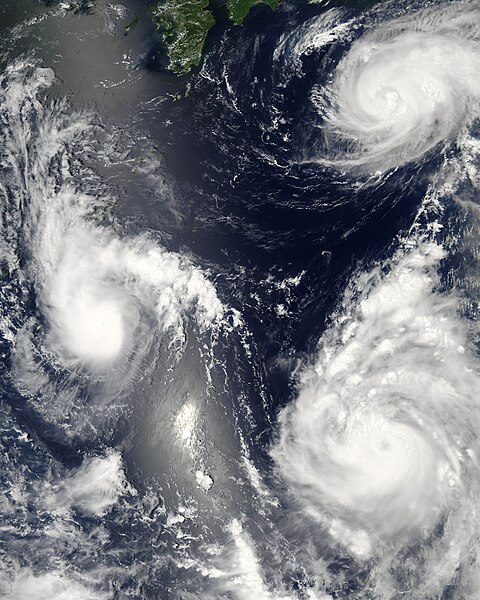Archivo:Maria, Bopha and Saomai 2006-08-07 0435Z.jpg
Apariencia

Tamaño de esta previsualización: 480 × 600 píxeles. Otras resoluciones: 192 × 240 píxeles · 384 × 480 píxeles · 614 × 768 píxeles · 819 × 1024 píxeles · 1638 × 2048 píxeles · 7200 × 9000 píxeles.
Ver la imagen en su resolución original (7200 × 9000 píxeles; tamaño de archivo: 7,6 MB; tipo MIME: image/jpeg)
Historial del archivo
Haz clic sobre una fecha y hora para ver el archivo tal como apareció en ese momento.
| Fecha y hora | Miniatura | Dimensiones | Usuario | Comentario | |
|---|---|---|---|---|---|
| actual | 03:06 8 ago 2006 |  | 7200 × 9000 (7,6 MB) | Good kitty | == Summary == {{Information |Description=Three different typhoons were spinning over the western Pacific Ocean on August 7, 2006, when the Moderate Resolution Imaging Spectroradiometer (MODIS) on NASA’s Aqua satellite acquired this image. The strongest |
Usos del archivo
La siguiente página usa este archivo:
Uso global del archivo
Las wikis siguientes utilizan este archivo:
- Uso en ar.wikipedia.org
- Uso en az.wikipedia.org
- Uso en bg.wikipedia.org
- Uso en bh.wikipedia.org
- Uso en crh.wikipedia.org
- Uso en cs.wikipedia.org
- Uso en de.wikipedia.org
- Uso en en.wikipedia.org
- Typhoon
- Typhoon Saomai
- Tropical cyclone
- Wikipedia:Picture peer review/Archives/Archive2006
- User:Plasticup/MyFavorites
- Typhoon Maria (2006)
- User talk:Hurricanehink/Archive 23
- User talk:Thegreatdr/2012archive
- Wikipedia:Wikipedia Signpost/2013-11-20/Traffic report
- Wikipedia:Wikipedia Signpost/Single/2013-11-20
- Wikipedia:Top 25 Report/November 10 to 16, 2013
- User:Tfmbty/2006 Pacific typhoon season
- User:SongdaTalas/Archives of Former Articles
- Uso en en.wiktionary.org
- Uso en fi.wikipedia.org
- Uso en hi.wikipedia.org
- Uso en id.wiktionary.org
- Uso en incubator.wikimedia.org
- Uso en ja.wikipedia.org
- Uso en ja.wikibooks.org
- Uso en ko.wikipedia.org
- Uso en lo.wikipedia.org
- Uso en ms.wikipedia.org
- Uso en my.wikipedia.org
- Uso en nn.wikipedia.org
- Uso en no.wikipedia.org
- Uso en pt.wikipedia.org
- Uso en ro.wikipedia.org
- Uso en ru.wikipedia.org
- Uso en szy.wikipedia.org
- Uso en th.wikipedia.org
- Uso en tk.wikipedia.org
- Uso en tr.wikipedia.org
Ver más uso global de este archivo.





